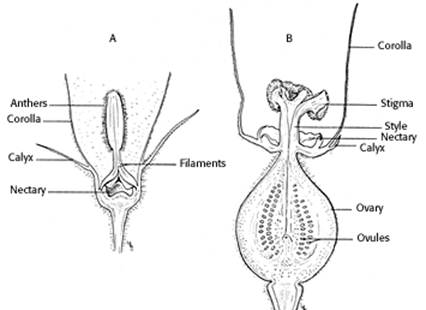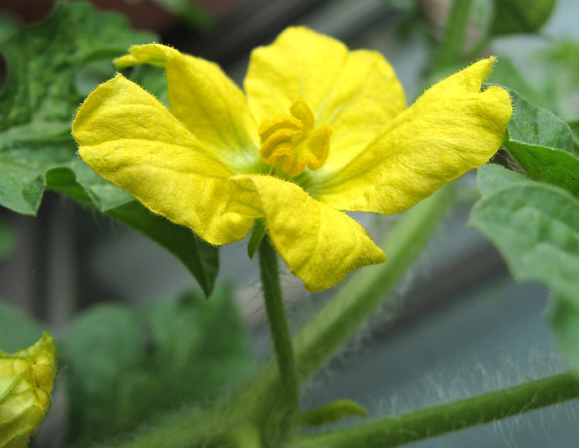Optimise watermelon crop pollination using honey bees
Dr Ian Biggs, Senior Research Agronomist, Katherine
Insect pollination is essential in watermelon due to the plant having separate male and female flowers (often on different plants) and the large sticky pollen grains which prevent other means of pollination. Each seed is formed from the union of a single pollen grain and a single ovule. Failure to pollinate will result in abortion of the fruit, while poor pollination results in small misshapen fruit. Each stigma requires at least 1000 pollen grains evenly distributed over all three lobes to ensure complete fertilisation of ovules. To achieve this, it has been estimated that at least nine bee visits per female flower is required. This is required in seedless melons as well, as it stimulates the required hormone production to ensure the production of large, well-shaped fruit.
 |  |
| Figure12: Immature melon with poor shape due to insufficient | Figure 14: Diagram of male (A) and female (B) melon flowers |
Rules for use of honeybees to optimise watermelon crop pollination:
- Healthy honeybee colonies to be installed.
- Select hive sites that allow all weather, 24 hour access for beekeepers.
- Timing of hive placement to ensure
target crop ready for bee pollination.
- Female flowers have appeared.
- At least 10% of crop in flower.
- Hives to remain for at least 3 weeks or for the duration of active flowering.
- Overhead irrigation and sprays are not to be conducted when flowers are open and bees are flying. Foliar sprays should be applied in the late evening or at night.
- Density of honeybee hives to be a minimum of 2.5 hives/ha with a target density of three to four hives/ha. A greater hive density maybe required to boost pollination if in-crop pollinating conditions are poor or if external conditions might distract honeybees from the target crop, e.g., rival flower source.
- Hive placement. This can be a point
of contention between the grower and beekeeper as the grower wants ready
access for the bees to the crop while the beekeeper wants easy access to
the hives.
- Slash grass in the area where hives are to be placed to ensure there are no high plants that may impede honeybee flight around the hive.
- Place hives so that they do not receive direct spray from irrigation systems or farm spray operations.
- Place hives so that there is no more than 500m to centre of target crop and no more than 300m between hive clusters.
- Place hives so that they are not in a hollow where cool air will pond.
- Place hives so that they receive morning sun.
- Remember bees like to work up hill and along crop rows.
- Place hives so that the target crop is between the hives and a competing flower source.
- Hives should be protected from strong winds and prevailing winds.
- Avoid walls or fences between hive and crop.
- Locate away from farm workers and livestock.
- Avoid dwellings and irrigation valves or locations which require regular visits from farm workers.
- Bees require access to clean water, especially during hot weather. Aim to have water 100 m from hive but no more than 500m. If using tanks place small floats on the water so as to reduce bee drowning.
- Alternative flower sources noted or removed.
- Ensure that all farm/crop chemicals used are low toxicity to bees and are used at evenings or when bees are not flying. Chemical residual times are noted and if necessary hives should be removed until toxicity hazard is reduced.
For more information visit the BeeAware website.
Explanation of rules:
Healthy honeybee colonies
Strong colonies are superior pollinators. To ensure colonies are in a healthy state, regularly observe bee activity and look out for dead bees around the hive. If anything unusual is observed contact your apiarist immediately.
Note that in tropical climates colonies are usually not as populous as temperate climates and tend to have more even numbers of bees throughout the year.
Site access
Beekeepers require an all-weather, easy access (including night access) for trucks and a bobcat. Ease of access will help ensure reduced labour costs for beekeepers and can help ensure preferred distribution of hives around farm and may reduce hive rental costs.
Timing of hive placement
While it is considered that watermelon flowers are moderately attractive to honeybees and a rich source of nectar and pollen, the pollen is deficient as a protein source. In addition, the relatively low flower density means bees can be easily distracted away from the watermelon crop to more plentiful flower sources. It is best to have bees that are inexperienced at foraging in the area of the crop. Ensure that alternative flower sources are either removed or hives placed away from these alternative sources.
Bees should be introduced when the first fruit-producing flowers appear and when 10 per cent of the crop is in flower. Honeybees should be kept on the crop for at least three weeks or as long as there is active flowering occurring.
Overhead irrigation and sprays
Overhead irrigation reduces bee foraging rate for nectar and pollen. Open flowers fill with water which dilutes nectar and reduces attractiveness to bees. Avoid irrigating or spraying during bloom times or during daylight hours, especially early morning when flowers are opening and bees are active.
Density of bees
The goal is to use the minimum hive density that provides maximum crop pollination and therefore maximum yield potential. Generally any factor that reduces overall pollination efficiency requires an increase in bee density to overcome.
A general starting density is 2.5 hives/ha though up to 6 hives/ha maybe required. Increasing hive number will depend on colony strength and weather. A greater hive density maybe required to boost pollination if in-crop pollinating conditions are poor or external conditions are likely to distract honeybees from the target crop, e.g., rival flower sources. Use grower and beekeepers experience to reach a final hive density for crop.
Hive placement
It is in the grower’s interest to ensure that hives are placed as close to the crop as possible and there is a uniform distribution of bee foraging over the crop to ensure uniform pollination. The number of foraging bees visiting the crop, the amount of pollen collected, and crop yields all generally increase the closer the hives are to the crop. Bees prefer to forage within 100 m of the hive and recommendations from the United States of America (USA) are generally for hives to be placed at 150 m intervals and within 150 m of the centre of the crop. However, it is known that A. millifera can forage over 2.5 km from the hive and Australian recommendations are for allowing up to 500 m foraging distance. Place hives so that all areas of the target crop are within 500 m of a hive. Ensure that the distance between hives is not more than 500 m and ideally less (~ 300 m). This will ensure there is competition between bees for floral resources in the target crop.
The foraging distance is reduced in cold and wet weather so there may be a need for greater hive dispersal if such conditions prevail.
Hives should be placed on knolls and away from hollows where cold night air might pool. Hives should be exposed to morning sun as this will stimulate bees to be active early in the day – a time which coincides with the watermelon flowering cycle.
Hives should be protected from prevailing winds and should also be sheltered from strong winds and rainy weather. Ensure no structures or vegetation inhibit bee access to the hive or travel between the hive and the target crop. There should be no solid barrier (wall or hedge) between the hive and the target crop.
Locate hives away from areas where is likely to be regular interaction with farm workers, pedestrians, livestock, and farm machinery movements. Also avoid dwellings, farm buildings, and irrigation valves.
Bees require easy and ready access to clean, non-contaminated water sources, especially in hot, dry weather. It is especially important that the water source is not contaminated with fertiliser runoff, e.g., nitrates. If an adequate natural water source is not available then alternative water sources will need to be provided. Ensure these water sources are within 100 to 500 m of hives and if required have floats on the surface to reduce bee drowning.
Alternative flower sources noted or removed
Honey bees are easily distracted from watermelon crops due to the low flower density and therefore low nectar and pollen resource. To reduce the risk of bees abandoning the target watermelon crop potential alternative flower sources should be removed where possible. This can be done by either mowing or herbicide. Where it is not possible to remove competing flower resources, locate hives on the opposite side of target melon crop from the distracting flowering plants.
 |  |
| Figure 15: A female watermelon flower | Figure 16: A male watermelon flower |
Farm/crop chemicals
Studies from the USA have measured 121 chemical residues in pollen samples and found on average 6.7 different chemicals pre pollen sample collected. Ensure that all chemicals used are low toxicity to bees and are used at evenings or when bees not flying and residual times noted. Care needs to be taken with systemic insecticides that may have been used in previous crops, e.g., seed dressings. There is some evidence that insecticides persist in soil for extended periods and are then being present at low levels in subsequent crops. While not toxic to adult honeybees, these sub-lethal levels are thought to predispose honeybees to other diseases, and may be toxic to bee larvae and young honey bees.
Other chemicals such as fungicides may not be toxic to adult bees. However, pollen from flowers sprayed with fungicide will have fungicide on the pollen. When this contaminated pollen is carried back to a hive the fungicide can be toxic to the brood.
You can check toxicity of chemicals by referring to the APVMA web site look for the environmental assessment section of chemical reports.
Useful websites
Give feedback about this page.
Share this page:
URL copied!